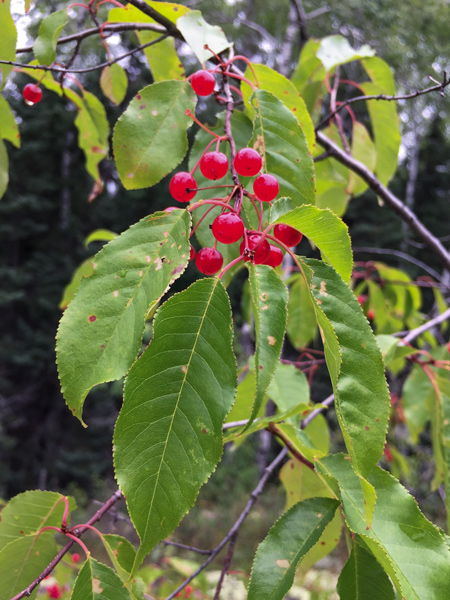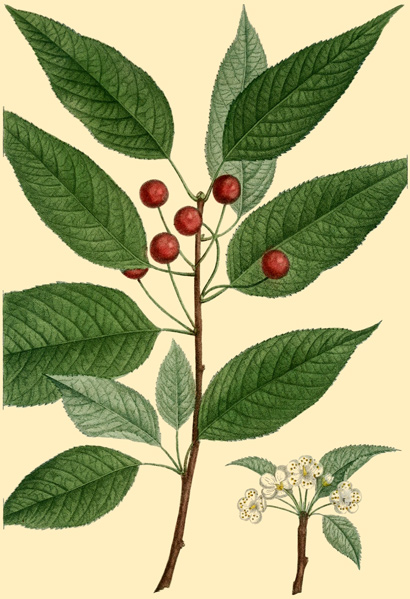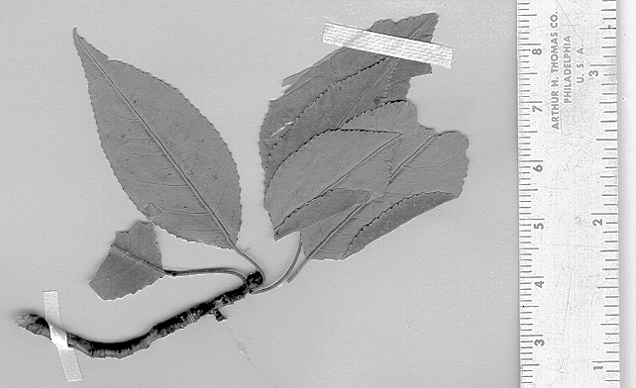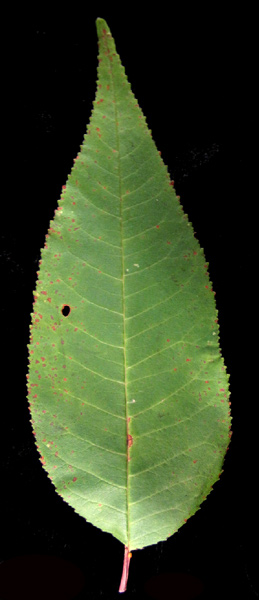A Most “singular Cherry”
Pin Cherry
Prunus Pensylvanica
Taken at Whiteshell Provincial Park, Manitoba by Mary Krieger. Permission to use granted under the Creative Commons Attribution-Share Alike 4.0 International license.
August 10 to 12, 1806 was an anxious and uneasy time for the Lewis and Clark Expedition. The two captains had not seen or heard of the other since 3 July 1806 when they left Travelers’ Rest in separate parties (see Dividing Forces at Travelers’ Rest). Everyone was a considerable distance below the mouth of the Yellowstone where they had previously agreed to meet, and the mosquitoes added to everyone’s discomfort.
Both captains report collecting a plant specimen on 10 August 1806: Lewis the white milkwort, Polygala alba, and William Clark gives an accurate description of the pin cherry, Prunus pensylvanica. In that description, he specifically says that he collected the plant. A poorly preserved specimen resembling the common chokecherry, Prunus virginiana is in the Lewis and Clark Herbarium and labeled as having been collected on this date. Clark did not often collect plants, nor he is known to have written the detailed botanical descriptions found in the journals. Instead, he most often copied from Lewis’s journal—a type of ‘backup’ system that they commonly employed.
The next day, 11 August 1803, all became chaos when Meriwether Lewis received a painful bullet wound across the buttocks. Because he feared an Indian attack, he called everyone to action and defensive positions were assumed. When no Indians could be found, they figured the shot must have come from one-eyed Pierre Cruzatte, who was also hunting in the general area and could have mistaken Lewis’s buckskin-clad frame for an elk grazing among the willows.[1]See Lewis’s Hunting Accident.
On 12 August 1806, the two parties finally connected at what is now called Reunion Bay. Because of his wound, Lewis remained prostrate. It was too painful to sit or walk, and he decided to delegate all journal writing—as he sometimes did previously—to Clark. Lewis explained:
as wrighting in my present situation is extreemly painfull to me I shall desist untill I recover and leave to my frind Capt. C. the continuation of our journal.[2]The Definitive Journals of Lewis & Clark, Gary Moulton, ed., 8:158.
Lewis’s Last Botanical Description
Red Cherry – Cerasus borealis
by H.J. Redoute (illustrator) and Gabriel (engraver)
From François André Michaux, The North American Sylva . . ., Augustus Luca Hillhouse, translator (1819), plate 90.
Before signing off in his last journal entry, Lewis had to botanize one last time. He concludes with an accurate description of the pin cherry, Prunus pensylvanica:
however I must notice a singular Cherry which is found on the Missouri in the bottom lands about the beaverbends and some little distance below the white earth river. this production is not very abundant even in the small tract of country to which it seems to be confined. the stem is compound erec and subdivided or branching without any regular order it rises to the hight of eight or ten feet seldom puting up more than one stem from the same root not growing in cops [copse] as the Choke Cherry dose. the bark is smooth and of a dark brown colour. the leaf is petiolate, oval acutely pointed at it’s apex, from one and a ¼ to 1½ inches in length and from ½ to ¾ of an inch in width, finely or minutely serrate, pale green and free from bubessence the fruit is a globular berry about the size of a buck-shot of a fine scarlet red; like the cherries cultivated in the U’ States each is supported by a seperate celindric flexable branch peduncle which issue from the extremities of the boughs the peduncle of this cherry swells as it approahes the fruit being largest at the point of insertion. the pulp of this fruit is of an agreeable ascid flavour and is now ripe. the style and stigma are permanent. I have never seen it in blume.[3]Ibid.
The plant was not new to science. The son of Carl Linnaeus, Carl the younger, described the plant in 1782. Had Frederick Pursh recognized it, he would have extended its known range at the time.[4]A. Scott Earle and James L. Reveal, Lewis and Clark’s Green World: The Expedition and its Plants (Helena, Montana: Farcountry Press, 2003), 216. The species grows in the mountains of Virginia and West Virginia, and may have been known to Lewis as well.
Lewis often turned to botanizing in times of stress. Given all that had happened with the fatal Blackfeet encounter, his hunting accident, and the delay in reuniting with his partner, his last entry may have been more for his mental well-being than for the promotion of useful knowledge.
`Native Uses
The pin cherry was not new to the Native Nations who lived within the cherry’s range: the northeast United States, Great Lakes, and mid-west and eastern Canada. It follows that most of their uses of P. pensylvanica come from Algonquian-speaking peoples. Among them, the plant had a far wider range of medicinal uses than other wild cherries encountered by the Lewis and Clark Expedition. In addition to coughs and colds, the plant was used to treat blood poisoning and as a blood tonic, stomach ailments, and chafing. Quebec Algonquins, Cherokees, Woodland Crees, Iroquois, and Ojibwas ate the fruit fresh and dried them or made pounded cakes for winter use.[5]Daniel E. Moerman, Native American Ethnobotany (Portland, Oregon: Timber Press, 1988), 442. The Potawatomis made an infusion of the inner bark to treat internal pain and the fruit was traditionally eaten while making baskets.[6]Huron H. Smith, “Ethnobotany of the Forest Potawatomi Indians,” Bulletin of the Public Museum of the City of Milwaukee 7, no. 1 (9 May 1933): 77, 108, … Continue reading
A Mysterious Specimen
Pin Cherry Leaf
Courtesy Bibliothèque de l’Université Laval, photograph by Avotte Gilles. Permission to use granted under the Creative Commons Attribution-Share Alike 4.0 International license.
In the Herbarium is a wild cherry specimen with a label that indicates that it “was found near the beaver bents on the Missouri—Augst: 10th 1806.” Paul Cutright argues that Lewis would not have collected two two different species here, so this specimen must be the same plant described by Lewis two days later—our pin cherry.[7]Paul R. Cutright, Lewis and Clark: Pioneering Naturalists (Lincoln and London: University of Nebraska Press, 1989 First Bison Books printing), 325. Reveal, Moulton, and Schuyler identify the specimen as the common chokecherry, P. virginiana. They also identify Lewis’s August 12 description as that of the common chokecherry.[8]James L. Reveal, Gary E. Moulton, and Alfred E. Schuyler, “The Lewis and Clark Collections of Vascular Plants: Names, Types, and Comments,” Proceedings of the Academy of Natural Sciences … Continue reading In the journals, Moulton identifies Lewis’s description as the pin cherry and notes that the specimen “may be the cherry in the Lewis and Clark herbarium.” In his Herbarium volume, however, it is again identified as the common chokecherry.[9]Journals, 7:159n7, emphasis added; Herbarium, 46, plate 141b.
Pursh’s copy of Lewis’s specimen label references the “beaver bends”—an area above the White Earth River which Lewis reached on 8 August 1806:
we reached the center of the beaver bends about 8 ms. by water and 3 by land above the entrance of White earth river. not finding Capt. Clark I knew not what calculation to make with rispect to his halting and therefore determined to proceed as tho’ he was not before me and leave the rest to the chapter of accedents.[10]Journals, 8:152.
The identity of who collected PH-LC 180 (Moulton sheet 141b) is also a mystery. As mentioned previously, Clark claimed to have collected it, but he was likely copying Lewis’s journal too closely, inserting material into a previous day as he often did. In the beaver bends, Lewis stopped for nearly two days. On the evening of 10 August, they encamped across from the mouth of the Little Muddy River—Lewis’s “White earth river”—below present-day Williston, North Dakota. During this period, Lewis had time to collect the specimen himself. Reveal speculates that the specimen was most likely collected by one of Lewis’s men on 12 August.[11]Reveal, Moulton, Schuyler, 41.
When comparing the leaves of Lewis’s specimen with the leaves the pin cherry, one could jump to the conclusion the specimen is a pin cherry. However, to properly identify plants, the observer usually needs more than one complete leaf and observations taken at various stages of the plant’s seasonal cycle. In the confusion of the Lewis and Clark reunion, the connection between a sparse, degraded specimen and Lewis’s description is uncertain.
Specimen Transcription
On the specimen sheet are several notations:
Stamp: Deposited by American Philosophical Society
Handwritten Label
Prunus demissa Nutt.
T. M [Thomas Meehan]
Handwritten Label
Prunus
A Cherry found near the beaver bents on the Missouri
Augst: 10th 1806.
Pursh’s copy of Lewis Ticket
Typewritten Label
Academy of Natural Sciences
Prunus virginiana L
Det: Erica Armstrong Date: 17 May 1994
Handwritten on sheet: Moulton 141b
Printed Label
American Philosophical Society.
LEWIS & CLARK HERBARIUM.
FROM THE ATLANTIC TO THE PACIFIC.
Handwritten: Prunus demissia Nutt.
[Locality, No., and Date left blank]
Perforation: ANS PHILA[12]Journals: Herbarium, 46, Plate 141b.
Analysis of Botanical Terms
The table below gives a brief analysis of the botanical terms Lewis used to describe the pin cherry. The first column is the term with Lewis’s alternate spellings—when they exist—enclosed in square brackets.
| Term | Definition | Barton Count | Miller Count |
| acute [acutely, accute] |
“ending in an acute angle” Barton 32; “sharply pointed” Kew 7 | 9 [acute] |
69 [acute, acutely] |
| apex | “tip or end . . . farthest removed from the base of insertion” Barton 43 | 18 | 71 [apex, apexes] |
| branched [branched, branching, unbranched] |
“subdivided,” Barton 15 | 12 [branched, branching, unbranched] |
7 [branched, branching] |
| compound | “subdivided into . . . . small branches” Barton 22; there are different meanings when applied to a fruit or an inflorescence, Kew 31 | 78 [compound, compounded] |
15 [compound, compounded] |
| cylindrical [cylindric, cilindric, cilindrical, celindrical] |
“formed into a cylinder, or equal tube” Barton 65 | 26 [cylincrical, cylindrica, cylindricae] |
47 [cylindraceum, cylindraceous, cylindrica, cylindrical, cylindric, cylindricum] |
| erect | “upright” Barton 72 | 11 | 106 [erect, erectly] |
| flexible [flaxable, flexible, flexeable] |
“bending easily but springing back to original shape,” Kew 49 | 4 | 0 |
| globular [globular, globelar] |
“spherical; round like a ball,” Barton 134 | 19 [globules, globular, globulest] |
5 [globule, globules] |
| oval [oval, ova] |
round” Barton 193 | 4 | 16 |
| peduncle [peduncle, peduncles] |
“a partial stem, or trunk, which supports the fructification, without the leaves” Barton 71 | 51 [peduncle, peduncles] |
21 [peduncle, peduncles, peduncled] |
| permanent | opposite of deciduous, Barton 31. Today, persistent is used, Kew 87 | 23 [permanent, persitentes, persistens] |
62 |
| petiolate [petiolate, peteolate] |
“growing on a petiole or foot stalk” Barton 41; “with a leaf stalk” Kew 87 | 4 [petiolate, petioled] |
1 [petiolated] |
| pubescence [pubersence, bubessence] |
“hairy appearance,” Barton 68 | 14 | 3 [pubes, pubescent] |
| serrate | “toothed like a saw” Barton 32 | 8 [serrate, serrated] |
7 [serrate, serrated] |
| smooth [smooth, smoth, mothe] |
“beardless” Barton 91; not rough or hairy, Kew 110 | 17 | 13 |
| stigma | “the summit or top of [the] female part of the plant . . . destined to receive the influence of the pollen, and transmit it to the germ” Barton 175 | 55 [stigma, stigmas] |
12 |
| style | “the middle portion of the pistil, which, in many plants, connects the stigma with the germ” Barton 172 | 71 [style, styles] |
128 [style, styles, stylus] |
The above definitions come primarily from:
- Benjamin Smith Barton, Elements of Botany: or Outlines of the Natural History of Vegetables (Philadelphia: 1803), www.google.com/books/edition/Elements_of_Botany_Or_Outlines_of_the_Na/Hk0aAAAAYAAJ?hl=en&gbpv=0.
When appropriate, additional modern definitions have been given for clarity or when today’s definition has changed. The modern definitions come from:
- Henk Beentje, The Kew Plant Glossary: An Illustrated Dictionary of Plant Terms (Royal Botanic Gardens: Kew Publishing, 2012).
- James G. Harris and Melinda Woolf Harris, Plant Identification Terminology: An Illustrated Glossary (Spring Lake, Utah: Spring Lake Publishing, 2009).
- James L. Reveal, on this website in Camas. See also by Reveal, Lewis as Botanist.
When not enclosed with quotation marks, the definition has been paraphrased from the given source.
In the two columns of word counts, every effort has been made to count only those instances where the intended meaning is the one given in the definition. Alternate forms—for example, claw, claws, clawed—have been counted. Latin equivalents have been excluded from the count except when they are used exclusively by the author.
John Miller’s counts come from his two-volume translation:
- John Miller, An Illustration of the Sexual System, Of Linnaeus (London, 1779), books.google.com/books/about/An_Illustration_of_the_Sexual_System_Of.html?id=ak8-AAAAcAAJ.
- John Miller, An Illustration of the Termini Botanici of Linnaeus (London, 1789), archive.org/details/illustrationofse02mill.
Notes
| ↑1 | See Lewis’s Hunting Accident. |
|---|---|
| ↑2 | The Definitive Journals of Lewis & Clark, Gary Moulton, ed., 8:158. |
| ↑3 | Ibid. |
| ↑4 | A. Scott Earle and James L. Reveal, Lewis and Clark’s Green World: The Expedition and its Plants (Helena, Montana: Farcountry Press, 2003), 216. |
| ↑5 | Daniel E. Moerman, Native American Ethnobotany (Portland, Oregon: Timber Press, 1988), 442. |
| ↑6 | Huron H. Smith, “Ethnobotany of the Forest Potawatomi Indians,” Bulletin of the Public Museum of the City of Milwaukee 7, no. 1 (9 May 1933): 77, 108, www.survivorlibrary.com/library/ethnobotany-of-the-forest-indians.pdf. |
| ↑7 | Paul R. Cutright, Lewis and Clark: Pioneering Naturalists (Lincoln and London: University of Nebraska Press, 1989 First Bison Books printing), 325. |
| ↑8 | James L. Reveal, Gary E. Moulton, and Alfred E. Schuyler, “The Lewis and Clark Collections of Vascular Plants: Names, Types, and Comments,” Proceedings of the Academy of Natural Sciences of Philadelphia 149 (29 January 1999): 41. |
| ↑9 | Journals, 7:159n7, emphasis added; Herbarium, 46, plate 141b. |
| ↑10 | Journals, 8:152. |
| ↑11 | Reveal, Moulton, Schuyler, 41. |
| ↑12 | Journals: Herbarium, 46, Plate 141b. |
Experience the Lewis and Clark Trail
The Lewis and Clark Trail Experience—our sister site at lewisandclark.travel—connects the world to people and places on the Lewis and Clark Trail.
Discover More
- The Lewis and Clark Expedition: Day by Day by Gary E. Moulton (University of Nebraska Press, 2018). The story in prose, 14 May 1804–23 September 1806.
- The Lewis and Clark Journals: An American Epic of Discovery (abridged) by Gary E. Moulton (University of Nebraska Press, 2003). Selected journal excerpts, 14 May 1804–23 September 1806.
- The Lewis and Clark Journals. by Gary E. Moulton (University of Nebraska Press, 1983–2001). The complete story in 13 volumes.





